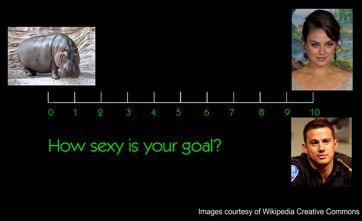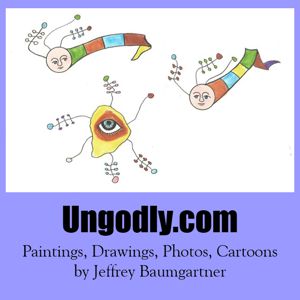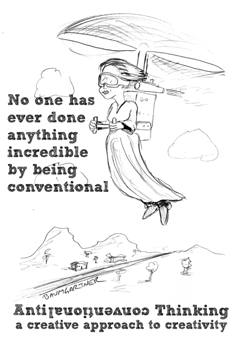
A Quick Introduction to
Anticonventional Thinking (ACT)
Revised Version 3.1
By Jeffrey Baumgartner
Anticonventional thinking (ACT) is a new approach to creativity that I have been developing since 2010 and which I first presented at the European Conference for Creativity and Innovation in September 2011. ACT was developed in response to the poor creative performance of brainstorming. ACT is modelled after the way highly creative people, such as artists, writers and composers collaborate on projects; current research into how the mind solves problems; and the need to implement ideas. As the name implies, ACT is about rejecting conventional thinking in favour of unconventional thinking in the creative process. It also rejects a lot of conventional notions about how to be creative, especially in groups.
Unlike brainstorming, creative problem solving (CPS), brainwriting and many other idea generation techniques that focus on generating large numbers of ideas, stressing quantity over quality, ACT aims to generate just one creative vision. Moreover, ACT breaks the cardinal rule of brainstorming: ACT not only permits criticism during the idea generation phase, but positively encourages it. Brainstorming and the like work on a diverge (lots of ideas) and then converge (reject ideas, combine ideas) basis. ACT uses a variable focused approach to develop an unconventional, creative vision.
In short, brainstorming, CPS and similar are about generating lots of ideas. And though CPS addresses the need to combine and build on ideas as well as to prepare a plan, it is vague about how to do this -- particularly compared to earlier steps in the process. ACT, in the other hand, is about playing with ideas to build a vision and an action plan.
Let us take a quick, step-by-step look at ACT.
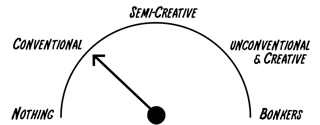
1. Make a Situation Transcendental
Life is a steady stream of situations in which we participate as individuals, groups, organisations and societies. In any of those situations, we have a choice of actions to take
- Do nothing.
- Do the conventional thing.
- Do something unusual but not creative (such as applying someone else's creative idea in a similar situation).
- Do something unconventional and creative.
- Do something bonkers and irrational (this is not desirable, as it implies insanity, but it is an option).
In most situations, we do the conventional thing without thinking about it. And when we do not know what the conventional thing is, we simply Google the situation and promptly learn the conventional action to take.
When you stop, think and decide not to do the conventional thing in a given situation, but instead to look for an unconventional, creative action you might take, it becomes a transcendental situation; it transcends ordinary situations where you would take conventional action.
Of course, you may eventually do nothing or opt to do the conventional thing. That does not matter, once you make a decision to at least seriously consider alternatives to the conventional, a situation becomes transcendental.
2. Play With the Situation
Once you have made a situation transcendental, you need to play with it for as long as possible. Absolutely do not start generating ideas -- this is a sure path to boring, conventional ideas! In order to be unconventional and creative, you need to understand a situation deeply. There are several ways you can do this.
Meditation
Meditation is an excellent way to visualise the situation and play with it, especially if you are working alone or with a small group -- although, even in a large group, members can meditate then share insights. In my workshops, I often lead meditation periods with surprising success. Participants inevitably come to me afterwards to share some kind of enlightenment that came as a result of the meditation.
The process I use in workshops is to follow Buddhist meditation techniques for breathing and relaxing. Then I invite people to enter into their own minds and once there, to visualise the situation sitting before them. Then I take them through a series of actions such as walking around the situation, looking at what is in the situation, looking at who is in the situation, seeing the situation from their perspective, smelling the situation, feeling the situation and so on. Eventually, I ask people to do unexpected and unconventional things to the situation, such as changing the colour of the situation, introducing animals into the situation and shrinking the situation, to name but a few. It is these unconventional things that usually lead to enlightenment, because it forces people to see their transcendental situation in new light.
Meditation need not be restricted to sitting in a lotus position and saying, "auum". One can also meditate will walking, sitting in the bath or sitting in a comfortable chair and staring off into the horizon. I personally go for long walks to meditate over situations. I find the movement relaxes me and the changing scenery and activity around me inspires insights.
Questioning and Anticonventional Questioning
Questioning is another great way to play with a situation. Moreover, if you are collaborating with a group, it is the best way to share the experience of playing with the situation. Questions should include conventional analysis questions and anticonventional questions.
Conventional analysis questions are the ones you always ask in transcendental situations. They are widely used by consultants and in CPS in order to understand the problem. They are effective, but a bit dull. Here are some examples:
- The five whys (asking why a problem exists and upon answering, asking why about the answer and repeating for five whys).
- Who is affected by the situation?
- Why do we not want to take conventional action in this situation?
- How would we like the situation to be in a year's time? In five years?
- What are the consequences of doing nothing?
Anticonventional thinking insists that you go further, in part by asking questions about feelings. These are important in business, but often forgotten in analysis. Feeling questions include:
- How do we feel about the situation? Why?
- How do our customers feel? Why?
- How would we like our customers to feel?
- How do people who are not our customers feel?
- How do our organisations decision makers feel about it?
Then you need to go further still, by asking anticonventional questions which force you to look at your situation in new ways, to associate it with seemingly unrelated information and facilitate playing with a situation. They are also much more fun than conventional analysis questions. Here are some examples:
- What does the situation sound like?
- What colour is it? What happens if we paint it red? Blue?
- What would Google do in this situation? What about McDonalds?
- What would happen if we let a penguin wander around the situation?
- How would a team in [name a country in a different continent] deal with the situation?
Be sure to take notes during this process, not only to record answers to the questions, but also to note down any inspirations or ideas that come to mind during the questioning. Of course, you should not focus on ideas at this point -- continue to play with the situation -- but it is inevitable that ideas will come to mind, so write them down and save them for later.
Do not worry if some of the answers are silly or if answering the questions leads to laughter. These are signs of creativity; encourage such behaviour!
Let the Situation Sit and Your Mind Wander
Unless you need to take action quickly, let the situation sit in the back of your mind for at least a day or two. Longer is better. As you go about your life, your mind will make various connections between your actions and the situation in the back of your mind. Often, you will not even be aware of these connections. You may find that when you wake up in the morning, you are inspired with new thoughts about the situation. Your mind organises and files away thoughts while you sleep and those connections your mind formed the day before meld into insights, ideas and new perspectives.
Going for walks or relaxing and allowing your mind to wander while vaguely aware of the situation is a powerful way to play with the situation and find inspiration. When the mind wanders, the dorsolateral prefrontal region of the brain -- the part I like to call the mental bureaucrat in your head because it is the region that vets ideas for suitability and typically rejects unconventional thinking -- becomes less active. As a result, your mind can really play with the situation and unexpected ideas are more likely to come to mind than if your mind is not wandering -- such as when you are at your desk at work.
3. Optional: Formulate a Sexy Goal (or Extreme Goal)
If you are collaborating in a group or intend to involve others in vision building, I recommend that you formulate a sexy goal (or "extreme goal" if you are in a culture where the term "sexy goal" might make people uncomfortable). It is important to note that in ACT we work with a goal where as CPS and brainstorming use problems. This is because, as I like to point out in my workshops, problems are for losers and goals are for winners. More seriously, working towards a goal generates a more positive feeling than solving a problem.
A sexy goal is one that is provocative, desirable and interesting. A good sexy goal helps to make people think differently about the situation enabling heir minds to connect unexpected ideas with the situation. For example, imagine you are tasked with designing a new camera for your company. Typical problem/challenge statements are: "In what ways might we improve upon our existing cameras?" or "What features might we include on our new camera?" These are fine problem statements, but they are conventional and focused on cameras. The result will surely be conventional camera ideas because participants will be visualising cameras while suggesting ideas.
A sexy goal is: "Describe a device that allows people to capture and share memories!" Do you see how this frees the mind from thinking about cameras and makes it easier to come up with creative, unconventional ideas?
Once you have formulated your first sexy goal, ask yourself if it is sexy (or extreme) enough. The answer is no, try harder. Repeat this process five times. In my workshops, I use the chart above to enable participants to rate how sexy their goal is.
If you are working alone or in a small group, you my not need to formulate a sexy goal -- you can simply move from playing with the situation to building a creative vision.
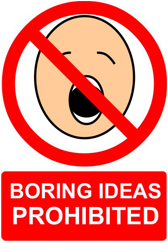 4.
Build a Creative Vision
4.
Build a Creative Vision
Building a vision in ACT is very different to the idea generation you probably know. In brainstorming and similar activities, you are told to generate as many ideas as possible and are forbidden to criticise or question ideas. The aim is to generate as many ideas as you possibly can.
In ACT you aim to build a single creative vision by testing ideas in your mind and rejecting those that are too conventional or not viable. Moreover, not only does ACT permit criticism and questioning of ideas, but you are encouraged to do so. ACT recognises that the only way that members of a group can understand ideas, especially the seemingly crazy ones, is by questioning them and criticising them. ACT also recognises that if you reject boring, conventional ideas, it puts participants into a mind set of rejecting boring ideas in their minds and pushing to be more creative. Lastly, ACT recognises research by the University of California, Berkeley which found that when idea generation groups are encouraged to criticise ideas, they generate significantly more creative results over a longer period of time. In my own experiences of running brainstorms (long ago), ACT and other ideation exercises, I have also seen that when respectful criticism is allowed, creativity thrives.
However, there are three rules for criticising ideas in ACT
- Always criticise boring and conventional ideas.
- Criticise the idea and not the person.
- After you have criticised an idea, you must be quiet and allow the idea owner or anyone else to defend the idea.
I also recommend that you try to pose your criticism as a question as this encourages debate and discussion.
Build Your Vision Through Trial and Error
Rather than generate a stream of ideas, in ACT you play with ideas. When an idea comes to mind, ask yourself first if it is conventional or, worse, boring. If so, drop the idea immediately before it corrupts your creativity. If you are collaborating and someone suggests a boring idea, criticise it, tell her the idea is boring. If you are new to ACT, I recommend that you make a list of the most conventional actions you might take in the transcendental situation. Then, you have a list of ideas to avoid. Moreover, you can use the list as inspiration, for example asking: "What would be the opposite of [conventional action]?"
If an idea is unconventional, imagine applying it to the situation. Ask, does it work? Is it viable? If not, how could you modify it to make it work? Is it unconventional enough (hint: the answer is "no") How you can make the idea crazier? Once an idea starts to work, build it up. You do not simply want an idea, you want a creative vision. So, think about the details, the features, the implementation, the potential problems and build the idea into a vision. If you hit a dead end and feel the vision is too conventional or is not coming together, drop the vision and start again.
As people suggest ideas, criticise and debate ideas that you feel are not viable. You will either find that the idea is better than you initially understood it to be or you will find that the idea is not good. In the latter case, you can not only drop the idea, but the train of thought that led to the idea, enabling you to follow other, more promising trains of thought.
Assuming creativity and eventually innovation is the final goal, continually ask yourself, or the group, "is this crazy enough? Can we make it crazier still?" The answers are almost always, "no" and "yes" respectively.
In a formal setting, such as a collaborative ACT session in your organisation, consider preparing the vision in the form of a story, a model, a drawing or a role-play. Doing so has a couple of advantages. Firstly, it makes it easier to share the vision within the group. Secondly, it enables you to test the vision as you go along. If you are preparing a story, for example, logical flaws in your thinking will be more obvious than if you are simply describing a vision. Lastly, a story or model is a great way to present the vision to others, such as managers who may have to approve its implementation.
5. Build an Action Plan
If possible, allow the creative vision to brew in your mind for a day or three before building an action plan. You will often find in the days following the vision building, new thoughts come to mind and you should discuss and apply them.
One of the challenges people face after any creative thinking activity is that ideas that seemed like jolly good fun during the creativity event can suddenly seem intimidating when those people return to their work desks and dozens of conventional distractions. This is why it is important at least to begin the action plan in a relaxed environment with participants of the group if it was a collaborative effort.
To make your creative vision less intimidating, break it into small, manageable steps. Assign someone overall responsibility for the vision implementation project and then assign individuals, from your ACT session group, to take responsibility for each step.
For more information, see What if You change IWWMI into WASNT? and How to Implement Your Creative Vision.
6. Do It
The number one reason that creative ideas do not get implemented is because no one implements them. Fortunately, that is an easy situation to rectify. Do it!
Check out the Anticonventional Thinking book.
ACT In Your Organisation
Would you like to use ACT as part of your innovation initiative? If so, let me know. I run interactive workshops training teams to use ACT in business situations, I facilitate ACT sessions around specific situations or goals and I can present ACT in a fun and interactive way at company events. I would love to help you and your colleagues use ACT as a part of your innovation process! You can find more about my workshops and other services here or, better yet contact me directly.
